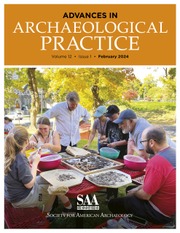Article contents
Transforming Legacy Spatial Data into Testable Hypotheses about Socioeconomic Organization
Published online by Cambridge University Press: 24 October 2019
Abstract
As archaeologists expand the accessibility of legacy data, they have an opportunity to use these datasets to design future research. We argue that legacy data can be a critical resource to help predict characteristics of sites and socioeconomic systems. In this article, we present a combined geographic information system (GIS) and network analysis methodology that turns site location data into testable hypotheses about site characteristics and the organization of regional settlement systems. We demonstrate the utility of this approach with a case study: Bronze Age (2700–1100 BC) settlement patterns in the mining region of Hunedoara in southwest Transylvania, Romania. We leverage unsystematically collected site location information in legacy datasets to develop testable predictions about sites, regional networks, and socioeconomic systems that can be evaluated through future systematic surveys and large-scale excavations. Such testable hypotheses can inform archaeological research design by providing a quantitative basis for determining where to focus research efforts and can also help secure funding and fieldwork permits. The method developed here can be applied in diverse archaeological contexts to reinvigorate legacy data as part of future archaeological research design.
A medida que los arqueólogos amplían la accesibilidad de los datos legados, tenemos la oportunidad de utilizar estos datos para diseñar investigaciones futuras. Proponemos que los datos legados pueden ser un recurso crítico para predecir las características de sitios arqueológicos y sistemas socioeconómicos. En este manuscrito, presentamos una metodología combinada de análisis de redes y SIG que convierte los datos de ubicación de sitios arqueológicos en hipótesis comprobables sobre las características del sitio y la organización de los sistemas regionales de asentamiento. Demostramos la utilidad de este enfoque con un caso práctico: patrones de asentamiento de la Edad de Bronce (2700-1100 aC) en la región minera de Hunedoara en el suroeste de Transilvania, Rumania. Aprovechamos la información de ubicación de sitios recopilada de manera no sistemática en conjuntos de datos legados para desarrollar predicciones comprobables sobre sitios, redes regionales y sistemas socioeconómicos que se pueden evaluar a través de encuestas sistemáticas futuras y excavaciones de gran escala. Dichas hipótesis comprobables pueden informar el diseño de la investigación arqueológica al proporcionar una base cuantitativa para determinar dónde enfocar los esfuerzos de investigación y utilizarse para ayudar a asegurar la financiación y los permisos de trabajo de campo. El método desarrollado aquí puede aplicarse en muchos contextos arqueológicos en todo el mundo para revitalizar los datos legados como parte del diseño de investigaciones arqueológicas futuras.
Keywords
Information
- Type
- Articles
- Information
- Copyright
- Copyright 2019 © Society for American Archaeology
References
REFERENCES CITED
- 4
- Cited by

